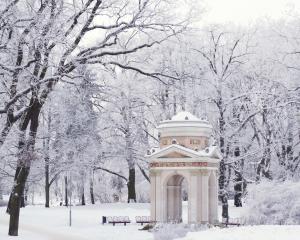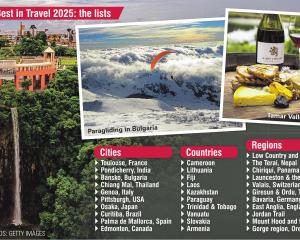The wildlife's not really that wild but the food is all it's cracked up to be, Miranda Spary reports.
I wassitting on the longdrop contemplating what made Tasmania so different from New Zealand, when some heavy breathing and grunting nearby had me grabbing for the torch.
Ten pairs of eyes glowed back at me from the darkness of the Australian bush: wallabies, wombats, possums, quolls - marsupial Peeping Toms all.
Luckily, we were at the camp of superguide Craig Williams, a sixth-generation Tasmanian who makes nervous visitors relax by the fire with enormous quantities of bush tucker and wine, while they wait for the native wildlife to come out to play and feed at dusk.
The wildlife is one big difference between the southern islands. I thought creatures such as Tasmanian devils, quolls and platypus must be mythical given their strangeness, but they're not.
Like our kiwis, they're real and you can easily see them in the wild or, very commonly, squashed on the road.
The Tasmanian devil is the beastliest. Creepy, beady-eyed and makers of a truly devilish noise, they have many unlikeable traits. Promiscuous to a fault, Mrs Devil hangs on to the sperm from any and all her lovers, so that her up to 70 offspring (it takes just three weeks for the rice-grain-sized embryos to appear) can have different fathers. Mr Devil is a violent and unromantic chap.
He takes huge chunks out of his girlfriend as he has his wicked way with her.
Tasmanian devils are endangered (strange, given their promiscuity, but only four teats on Mrs Devil means only four babies make maturity) but they are still not tricky to spot in the open. You can adopt one to assist with a breeding programme that is helping to change their status. Nobody wants to see them go the way of the Tasmanian tiger, which hasn't been seen for a long time.
Our own local superstar, Sam Neill, is in a recently released film, The Hunter, about a mercenary sent on a secret mission to get hold of a Tasmanian tiger for its genetic material. Sam says he loved Tasmania, although he couldn't understand why everyone thinks it's so like New Zealand.
According to him, it's not just the wildlife that's different, but also the history, which is so much bloodier and older than ours. Bad history makes for fascinating tourism, and I was much drawn to an exhibition at the museum about the convict transports featuring "Notorious Strumpets and Dangerous Girls".
It's hard to build pyramids and palaces without slave labour and the convicts provided all the labour and expertise necessary to create Tasmania's many elegant Georgian stone buildings.
While some are still private homes, many others are open to the public as hotels, cooking schools, restaurants and galleries.
Red Feather Inn is one such.
Just 10 minutes from Launceston, this five-bedroom deliciously cosy and comfortable hotel is set in beautiful grounds so perfect for weddings that they have recently had to limit the number they cater for each year. On site is also an excellent cooking school and we were lucky to have another Otago-born food guru with us when we took part. Richard Till had heard rumours about the excellent Tasmanian potatoes, and as a man with a bit of a penchant for a spud or two, had spent the day searching for Dutch creams and pink eyes to bring along to class (they were delicious).
Our teacher was Tanya. She and her husband Ian run the Red Feather Inn. She's not just a chef, but a florist as well, and while I know I'll be making the super and super-simple recipes she showed us - smoked salmon rillettes, baked quail with pickled cherries and beetroot risotto, followed by hazelnut meringues with reduced riesling syrup - my version will never look as beautiful as hers.
Food and wine in Tasmania is famously good (although Central Otago vineyard owner Sam Neill harumphs a little about their pinot noir) and the meal at Stillwater Restaurant in Launceston was not just fine, but utterly fabulous.
Owner Kim Seagram showed us round the historic flour mill on the edge of the Tamar River then sat us in the wine cellar where we happily munched and sipped our way through the outstanding degustation menu.
There was total chaos as we failed to agree on which were the standout food and wine courses. Everyone chose a different one.
As always in a small town, people are involved in many areas. Kim is no exception and next morning we saw her wearing a different hat, this time at Harvest, the newly established Launceston farmers' market she helped set up. Strictly local and producers only, it proved Tasmania really is home to some great farmers and growers.
Cheeses from everything that produces milk, including buffalo mozzarella; sheep's milk yoghurt; wooden crates full of recyclable glass bottles of milk with solid cream on the top; herb-coated chèvre and full-cream yoghurts had us salivating, and the prices only served to remind us how expensive New Zealand food has become.
As well as a food producer, Tasmania is one of only three countries legally producing opium. It's a beautiful crop when in flower, but the drug squad swoops quickly to remove any strays that escape into neighbouring gardens.
Just like New Zealand, Tasmania has lots of mountains and more than 7000 lakes. It has rugged coastline and sheltered beaches. It even has a skifield.
There are no snowmakers, so on the days that snow falls, Ben Lomond is very busy. Some years the season goes on for two whole weeks. It's a magical spot and even in summer people stay in chalets and lodges on the mountain, climbing and hiking in the strange spiky-looking rocks, called dolorite, which only exist here, in Argentina and the Antarctic.
Cradle Mountain is another tourist hotspot. With every type of accommodation available, it has huge appeal. Dozens of walks from 10 minutes to six days start from here.
If, by some miracle, you haven't seen enough wildlife just doing its own thing in the wild, Cradle Mountain has sanctuaries where you can see the creatures in captivity. Not the same thing as finding them yourself, but it is fascinating getting so close and the talks from experts are great. I did find it difficult to keep watching the Tasmanian devil video as a real devil started tearing its breakfast apart outside, and a spotted quoll did some excellent gym routines in its garden.
Yes, the wildlife in Tasmania is different from our own. But it is no less fascinating for that.
- Queenstown-based Miranda Spary travelled courtesy of Air New Zealand and was hosted by Tourism Australia and Tourism Tasmania.












